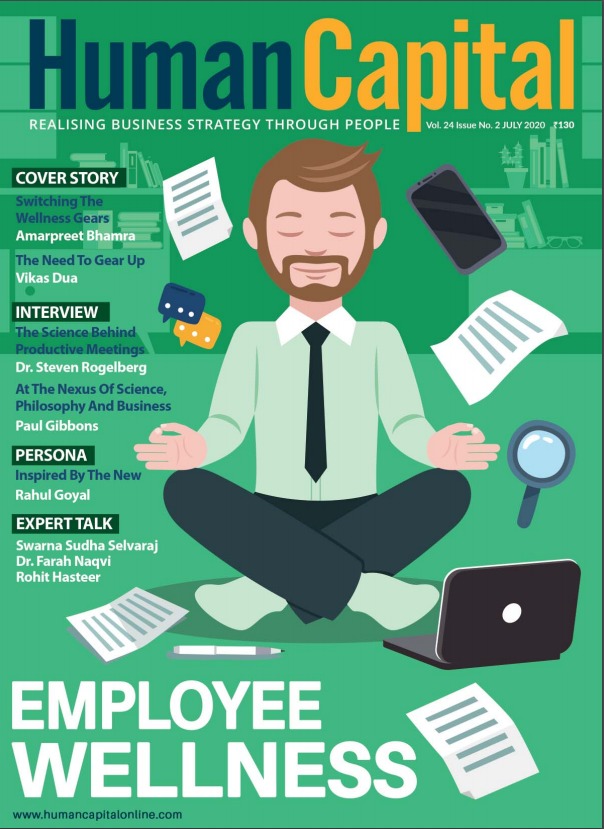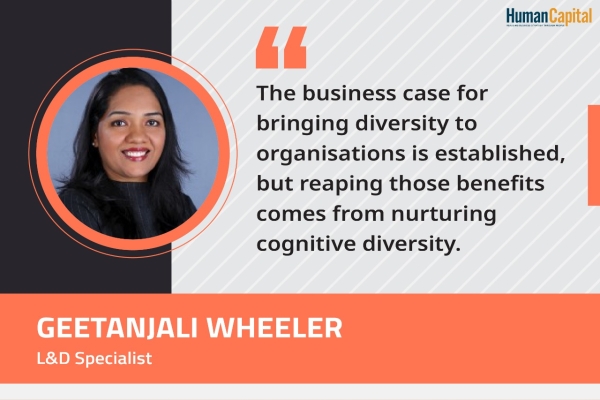“Today’s marketplace is incredibly competitive in every industry around the globe. The difference between success and failure is talent, period.” – Indra Nooyi
As we meander into the twenty first century, it is becoming increasingly evident that achieving success is based on the ability to co-exist with ambiguity and re-inventing oneself quickly, in short, adapting to unparalleled change. Yet, most of the management and talent practices are based on an organisation model that now stands dated and static, resulting in organisations not being able to stay in step with the people who work in them. Therefore, companies that make sustained investments in talent are well positioned to outdo their competitors.
Today, the norms of valuation have changed radically as well. For listed companies, a key driver is the rise of the intangible value of the company. While valuation was previously based on equipment, facilities, technology, resources, today, most of it is based on brand, relationships, talent, and the ability to innovate and execute quickly. It has, therefore, rightly been observed that empires of the future, will be empires of the mind. But developing a talent culture is anything but easy. Some of the key questions that need to be asked, or shifts that need to be made include:
1. How do you move from seeing people as a cost to seeing people as fundamental assets?
2. How can you develop a culture that is challenging and demanding but respectful as well?
3. How can you nurture the competitive spirit and then ensure that your workforce collaborates?
4. How can a job be seen as a career?
5. How can autonomy and mastery co-exist with process and alignment?
The corner stone of true competitiveness
These are a few queries which need to be addressed through a Talent Management strategy. So, a holistic Talent Management strategy is the cornerstone of true competitiveness. In order to adopt talent management, it is pertinent that some key steps are in place. As is often the case, it starts with the Leader. For instance, Jack Welch regularly took classes at GE’s Crotonville, and indicated his focus on Talent development be known by way of action. Talent can always be open to the Buy vs Build debate, but building, nurturing talent from the ground below carries an organic value, which good leaders understand intrinsically. Sam Walton too had an employee first approach to development. Leaders in several organisations, such as P&G, Pepsico, GE are known to focus on closely reviewing talent progression, and such reviews are as intense as financial reviews. Flowing from the Leader’s commitment is the HoD or the Division Head’s focus areas. The HoD always has the option of being an early adopter. The HoD has the advantage of a smaller canvas to draw upon. This is more compact and makes the dissemination a lot easier.
Nurturing the human capital
But, while the leaders provide the mindset and direction, it requires infrastructure to push the culture to one that is talent centric. This mindset needs to imbue every process from the plan to hire, to hiring, to learning, and work in practice; all structured on a competency framework, which itself is anchored on nurturing the human capital in the organisation. These processes are common in most organisations, however, they are largely operated as tactical processes, and not really speaking to a larger talent centric vision. However, there is so much that one needs to prioritize. And, priorities stem from where it pinches the most for an organisation. So, if you are a contact centre reeling under retention problems, then employee engagement would be key, and retention programmes would be paramount. But whatever the priority, overall robustness of processes is required to ensure sound results.
The next key step, according to David C. Forman, is to ensure buy-in for the talent mindset, a guiding coalition, so to say. It is important to align the key stakeholders towards the side of the talent centric view. There are numerous ways to get such coalitions to support. The Strategic Leadership Team, the People Committee comprising all those in people-related functions, etc. all can play pivotal roles in ensuring that there is a strong buy-in for this go forward vision.
Aligning the pivotal role
Next is to align the most pivotal role in your direction. The Manager must feel the value that comes from an enthused team; she needs to ensure that hiring, training, learning, retaining and developing top talent is part of her key deliverables, and not something which is good to do, but optional. Typically, this is not easy, the Managers are geared to deal with the day to day, the weekly, and are often stuck in old perceptions. They are not the one to grow, inspire, involve and reward talented employees, so easily. A paradigm shift is easier said than done. Often, this takes a long time to accomplish.
The last and perhaps the most critical, and desirable step as well, is when the employee takes responsibility for her own learning. Today in an ecosystem of change, individuals realize, irrespective of the degrees they own, unlearning and re-learning is what will keep anyone relevant in the market. Hence, the moment they own responsibility, the journey of the talent-centred organisation completes the loop. When people take responsibility for their choices, there is an improvement in engagement and increase in productivity. Of course, only the best of organisations recognize, and more importantly, enable this. For example, IBM allows its employees to keep the skill inventory database updated by registering any new skills they may have acquired. And, this is then actively aligned to the job opportunities that open up time to time within the organisation. The employee can then be informed about the roles that have opened up for their skillsets. A win-win situation for the employee and a skill sensitive organisation scouting for the right talent.
Companies that have traversed the above journey are often known as Academy companies. Familiar names in the list are GE, Google, IBM, P&G, HP and the list goes on. However, smaller and nimble companies are also adopting robust talent practices, which allow them to be geared for change, and operate comfortably in a dynamic market. The command and control companies, the stiff neck gruff bureaucratic companies need to move to this new paradigm or risk closure through obsolescence. The hardest step in this journey is perhaps when the line Manager becomes the Talent Leader. When this change happens, and the employee too reciprocates by taking change in his or her stride, then barriers of tradition and inertia are broken, and the transformation to a high performing organisation takes place. The journey to talent centricity is no longer just an alternative, it is the key mechanism for an organisation to come into its own and succeed in the face of stiff competition. It is in short, your twenty first century competitive strategy.
Has COVID-19 forever changed the way we live and work?
Trending
-
SBI General Insurance Launches Digital Health Campaign
-
CredR Rolls Out 'Life Happens' Leave For Its Employees
-
Meesho Announces 30-Week Gender-Neutral Parental Leave Policy
-
Microsoft Unveils Tech Resilience Curriculum To Foster An Inclusive Future
-
60% Indian Professionals Looking For Job Change Due To COVID: Survey
-
SpringPeople And Siemens Collaborate For Digital Transformation Push
-
86% Professionals Believe Hybrid Work Is Essential For Work Life Balance: Report
-
Almost 1 In Every 3 People's Personal Life Affected Due To Work Stress
-
Meesho Rolls Out Reset And Recharge Policy For Employees
-
80% Of Talent Leaders & Academics Say Pandemic Changed Skill Needs For Youth: Report
-
Hero Electric Rolls Out 'Hero Care' Program For Employees
-
Human Capital In Collaboration With ASSOCHAM Hosts Virtual Conference
-
IKEA India, Tata STRIVE Collaborate To Create Employability And Entrepreneurship Opportunities
-
SAP India, Microsoft Launch Tech Skilling Program for Young Women
-
DXC Technology, NASSCOM Collaborate For Employability Skills Program
-
Lenskart To Hire Over 2000 Employees Across India By 2022
-
Mindtree Launches Learn-and-Earn Program
-
Tata AIA Extends 'Raksha Ka Teeka' To Its Employees
-
Swadesh Behera Is The New CPO Of Titan
-
NetConnect Global Plans To Recruit 5000 Tech Professionals In India
-
Hubhopper Plans To Hire 60% Of Indian Podcasters By 2022
-
Corporate India Needs More Women In Leadership Roles: Report
-
Aon to Invest $30 Million and Create 10,000 Apprenticeships by 2030
-
Tech Mahindra Launches ‘Gift a Career’ Initiative for Upskilling of Youth
-
40% Women Prefer Flexible Working Options in Post-COVID World: Survey
-
3 out of 4 companies believe they can effectively hire employees virtually: Report
-
Vodafone , CGI and NASSCOM Foundation launch digital skills platform
-
Odisha: Bank, postal employees to deliver cash for elderly, differently-abled persons
-
Skill India launches AI-based digital platform for "Skilled Workforce"
-
Hiring activity declines 6.73% in first quarter: Survey
-
70% startups impacted by COVID-19 pandemic
-
Bajaj Allianz Life ropes in Santanu Banerjee as CHRO
-
Over 70 Percent MSMEs look at cutting jobs to sustain businesses
-
93 Per Cent employees stressed about returning to office post-lockdown
-
Johnson & Johnson India announces family benefits for same gender partners
-
Indian firms turning friendly towards working mothers
-
Welspun India names Rajendra Mehta as new CHRO
-
Wipro partners with NASSCOM to launch Future Skills platform



Human Capital is niche media organisation for HR and Corporate. Our aim is to create an outstanding user experience for all our clients, readers, employers and employees through inspiring, industry-leading content pieces in the form of case studies, analysis, expert reports, authored articles and blogs. We cover topics such as talent acquisition, learning and development, diversity and inclusion, leadership, compensation, recruitment and many more.
Subscribe Now



.PNG)









































Comment